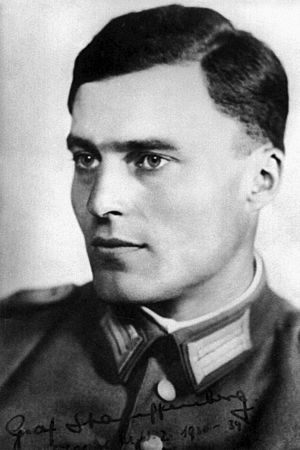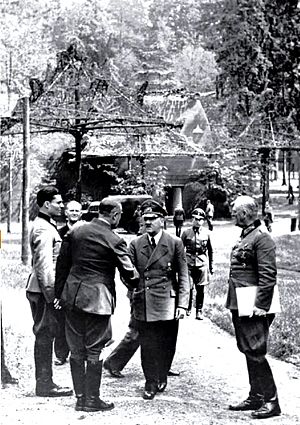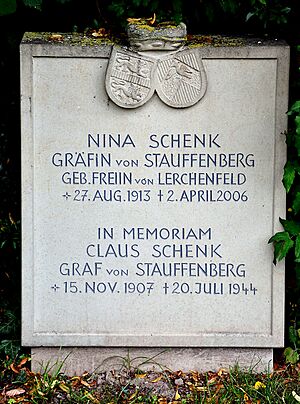Claus von Stauffenberg facts for kids
Quick facts for kids
Claus von Stauffenberg
|
|
|---|---|
 |
|
| Birth name | Claus Philipp Maria Justinian Schenk Graf von Stauffenberg |
| Born | 15 November 1907 Jettingen, Bavaria, German Empire |
| Died | 21 July 1944 (aged 36) Berlin, Gau Berlin, Nazi Germany |
| Cause of death | Execution by firing squad |
| Allegiance |
|
| Branch |
|
| Years | 1926–1944 |
| Rank | Oberst im Generalstab |
| Battles | |
| Spouse(s) |
Magdalena Freiin von Lerchenfeld
(m. 1933) |
| Children | 5, including Berthold, Franz-Ludwig and Konstanze |
| Relations |
|
Colonel Claus Philipp Maria Justinian Schenk Graf von Stauffenberg (15 November 1907 – 21 July 1944) was a German army officer. He is best known for his brave but failed attempt on 20 July 1944 to stop Adolf Hitler at the Wolf's Lair.
Even though Stauffenberg first supported some parts of the Nazi Party's ideas, he later joined a secret group of people who resisted Hitler. This group was part of the German army, known as the Wehrmacht. Stauffenberg, along with Major General Henning von Tresckow and General Hans Oster, was a key leader in the fight against Hitler. Soon after the plan, called Operation Valkyrie, failed, he was executed by a firing squad.
As a military officer from a noble family, Stauffenberg fought in the Invasion of Poland, the invasion of the Soviet Union in 1941-42, and the Tunisian Campaign during World War II.
Contents
Who Was Claus von Stauffenberg?
Claus Philipp Maria Justinian Stauffenberg was born on 15 November 1907 in Jettingen, Germany. His parents came from important noble families. His father, Alfred Schenk Graf von Stauffenberg, held a high position in the Kingdom of Württemberg. His mother, Caroline Schenk Gräfin von Stauffenberg, also came from a noble background.
From birth, Stauffenberg had the titles of Graf (Count) and Schenk (Cupbearer). These titles were later removed by law in 1919.
Stauffenberg's Early Life and Military Career
Stauffenberg grew up in Bavaria. He and his brothers were part of a German Scout group. Even though he loved literature, he chose a military career, following his family's tradition. In 1926, he joined the 17th Cavalry Regiment in Bamberg.
Around this time, he and his brothers met the poet Stefan George. Many people from George's group later became important members of the German resistance.
By 1930, Stauffenberg became a second lieutenant. He studied modern weapons but also focused on using horses in warfare. His regiment became part of the German 1st Light Division. This unit moved into Sudetenland after it was taken over by Germany.
How Did Stauffenberg View Nazism?
Stauffenberg never joined the Nazi Party. However, in 1932, he showed some support for Hitler's ideas about national unity and fighting corruption.
But Stauffenberg's views changed over time. He disliked Hitler's policies more and more. Events like "The Night of the Long Knives" and "Kristallnacht" showed him that Hitler was not interested in justice. As a Catholic, Stauffenberg was deeply offended by the unfair treatment of Jewish people and the suppression of religion.
Stauffenberg in World War II
Fighting in Poland and France (1939–1940)
When World War II began in 1939, Stauffenberg and his regiment fought in the Invasion of Poland. At first, he supported Germany taking over Poland. He believed that Germany should colonize these Eastern lands, similar to what the Teutonic Knights had done long ago.
After the invasion, Stauffenberg's unit became the 6th Panzer Division. He served as an officer in the Battle of France and received the Iron Cross First Class.
His uncle, Nikolaus Graf von Üxküll-Gyllenband, tried to get Stauffenberg to join the resistance against Hitler. Stauffenberg thought about it but refused at the time. He felt that German soldiers had sworn loyalty to Hitler personally, not to the government.
On the Eastern Front (1941–1942)
From 1940 to 1941, Stauffenberg worked for the Army High Command (OKH). This group was planning the German invasion of the Soviet Union. Stauffenberg did not join any plots at this time. However, his brothers kept in touch with anti-Hitler groups like the Kreisau Circle.
Stauffenberg openly spoke about the terrible treatment of Jewish people. In 1942, he told other officers that "They are shooting Jews in masses. These crimes must not be allowed to continue."
Wounded in Tunisia (1943)
In November 1942, the Allies landed in North Africa. Stauffenberg's 10th Panzer Division was sent to fight in the Tunisia Campaign. In 1943, he was promoted to lieutenant-colonel.
On 7 April 1943, Stauffenberg was driving between units when his vehicle was attacked by Allied fighter planes. He was badly wounded, losing his left eye, his right hand, and two fingers on his left hand. He spent three months recovering in a hospital. For his bravery, he received the Wound Badge in Gold and the German Cross in Gold.
Joining the Resistance (1943–1944)
After recovering, Stauffenberg was frustrated that he couldn't lead a coup himself. But in September 1943, he joined the conspirators. He became a staff officer at the headquarters of the Replacement Army in Berlin. This building was on Bendlerstrasse, which is now called Stauffenbergstrasse.
One of his bosses there was General Friedrich Olbricht, who was also part of the resistance. The Replacement Army had a special plan called Operation Valkyrie. This plan was meant to take control of the country if communications were cut off. Hitler had approved the plan, but the conspirators secretly changed it. They planned to use it to take power after Hitler was dead.
Stauffenberg became a key leader in the resistance. He helped develop a detailed military plan to take over Berlin and other army headquarters.
By D-Day, 6 June 1944, Stauffenberg knew the war was lost. He believed that only an immediate peace could save Germany from more destruction. However, his peace demands included Germany keeping its 1914 eastern borders and other territorial gains. He also wanted no Allied occupation of Germany.
The 20 July Plot

From September 1943 until 20 July 1944, Stauffenberg was the main force behind the plan to kill Hitler and take control of Germany. His strong will and organizational skills pushed the conspirators into action.
Stauffenberg knew he was committing high treason under German law. He told a young conspirator, "I am committing high treason with all means at my disposal." He believed it was his right to protect millions of lives from Hitler's terrible actions.
When another conspirator, General Helmuth Stieff, couldn't bring himself to kill Hitler, Stauffenberg decided to do it himself. He also had to start the military coup in Berlin on the same day. This made the plan much harder to succeed.
The Assassination Attempt
On 20 July 1944, Stauffenberg went to the Wolfsschanze (Wolf's Lair), Hitler's headquarters. He carried a briefcase with two small bombs. The meeting was in a wooden hut, not the usual underground bunker, because of the summer heat.
Stauffenberg went to arm the first bomb. This was hard because he had lost his right hand and had only three fingers on his left. A guard rushed him, so he could only arm one bomb. He left the second bomb with his assistant, Werner von Haeften.
Stauffenberg then placed the briefcase under the conference table, as close to Hitler as possible. A few minutes later, he left the room after receiving a planned phone call. After he left, Colonel Heinz Brandt moved the briefcase.
When the bomb exploded, Stauffenberg believed no one could have survived. Four people died, and many were injured. But Hitler was protected by the heavy oak table leg and was only slightly hurt.
Stauffenberg and Haeften quickly left and drove to a nearby airfield. Back in Berlin, Stauffenberg tried to start the coup. But when Joseph Goebbels announced on the radio that Hitler had survived, the conspirators knew the plan had failed. They were found at their offices and captured after a short shootout. Stauffenberg was wounded in the shoulder.
Execution and Aftermath
General Friedrich Fromm, who was also involved, tried to save himself. He quickly held a court martial and sentenced the leaders of the plot to death. Stauffenberg, Werner von Haeften, General Friedrich Olbricht, and Colonel Albrecht Mertz von Quirnheim were executed by firing squad before 1:00 AM on 21 July 1944.
Fromm ordered them to be buried with military honors. However, the next day, Stauffenberg's body was dug up by the SS, stripped of his medals, and cremated.
Stauffenberg's older brother, Berthold, was also a key figure in the plot. He was tried and executed on 10 August 1944. More than 200 people were condemned and executed after the 20 July Plot. Hitler used the plot as an excuse to get rid of anyone he thought might oppose him.
Stauffenberg's Legacy
After the war, Stauffenberg became a symbol of German resistance against Hitler. His actions showed that not all Germans supported the Nazi regime.
Today, the Bendlerblock in Berlin, where Stauffenberg worked and was executed, houses the Memorial to the German Resistance. This museum has many photos and documents about the different resistance groups during Hitler's time. The courtyard where the officers were shot is now a memorial site. It has a plaque and a bronze statue honoring those who fought against Hitler.
Stauffenberg's Family
Stauffenberg married Nina Freiin von Lerchenfeld on 26 September 1933. They had five children: Berthold, Heimeran, Franz-Ludwig, Valerie, and Konstanze. Konstanze was born seven months after Stauffenberg's execution.
After the plot, the children were not told about their father's actions. They were placed in foster homes and had to use new last names because "Stauffenberg" was considered dangerous.
Nina died in 2006 at the age of 92. Stauffenberg's son, Berthold, became a general in West Germany's army. His son, Franz-Ludwig, became a member of the German and European parliaments. In 2008, his daughter Konstanze wrote a popular book about her mother.
In Popular Culture
Claus von Stauffenberg's story has been told in many movies and TV shows. These include War and Remembrance (1988), The Plot to Kill Hitler (1990), Stauffenberg (2004), and Valkyrie (2008), where he was played by Tom Cruise.
See also
 In Spanish: Claus von Stauffenberg para niños
In Spanish: Claus von Stauffenberg para niños
- Assassination attempts on Adolf Hitler
- Melitta Schenk Gräfin von Stauffenberg



